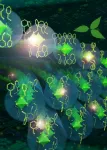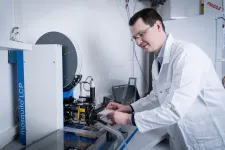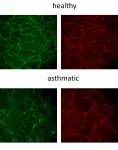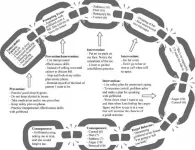(Press-News.org) A recent study analyses data collect4d at 44 of the darkest places in the world, including the Canary Island Observatories, to develop the first complete reference method to measure the natural brightness of the night sky using low-cost photometers.
Of the 44 photometers in the survey, the Roque de los Muchachos Observatory (Garafía, La Palma, Canary Islands) stands out at the darkest of all the skies analysed.
The night sky is not completely dark; even in the remotest places there is a glow in the sky produced by natural components, both terrestrial and extraterrestrial, and by artificial lighting of human origin. Even though the main bright sources such as the Moon, the Milky Way, and the Zodiacal light are easily recognisable, there is a glow which dominates the sky brightness on the darkest nights, produced in the upper layers of the atmosphere, and whose strength depends on a set of complex factors such as the time of year, the geographical location, and the solar cycle.
Solar Cycles are ordered in periods of activity lasting 11 years. We refer to solar maximum when the activity of the Sun has grown, sunspots appear on its surface, and its radiative emission has grown, which affects the molecules in the Earth's atmosphere, causing an increase in the brightness of the night sky. When these events are much reduced we call this solar minimum.
In 2018 Solar Cycle 24 entered into this phase and since then a series of photometers, TESS, situated around the world, have collected 11 million measurements which have been used to define a method of reference for the study of natural darkness with equipment of this kind. Among the results in the article, which will soon be published in The Astronomical Journal, there are outstanding "systematic observations of short period variations (of the order of tens of minutes, or of hours) in the brightness of the sky, independently of the site, the season, the time of night, or of solar activity, and which have been shown, for the first time, with low cost photometers, to be associated with events produced in the upper layers of the mesosphere, that is to say to the "airglow", explains Miguel R. Alarcón, a researcher at the Instituto de Astrofísica de Canarias (IAC) and first author of the article.
"This work has demonstrated the high sensitivity of low-cost photometers if they are linked in a network. The final analysis of the full set of TESS photometers shows the Gegenschein, a faint glow in the night sky, visible around the ecliptic, the same plane on which we see the zodiacal light and the planets" explains Miquel Serra-Ricart, an astronomer at the IAC and a co-author of the article. "The network of photometers has shown, yet again, that the Canary Observatories are in the First Division" he adds.
From the 44 photometers which took data from such places as Namibia, Australia, Mexico, Argentina and the United States, among others, it was possible to determine that the Roque de los Muchachos Observatory (ORM, Garafía, La Palma, Canary Islands) is the darkest of all of them". As can be read in the article, the darkness at the ORM is very close to natural darkness, artificial light adds only 2% to the sky background. From the network of photometers installed in the Spanish Peninsula, we should pick out the excellent sky darkness in the Community of Extremadura, the region of Montsec (Lleida), Javalambre (Teruel) the Sierra Nevada and the Pyrenees in Navarre.
Studying light pollution
The glow produced by the scattering of artificial light at night (ALAN) by the components of the atmosphere (gas molecules, aerosols, clouds...) is known as artificial skyglow. Estimates suggest that more than 10% of the Earth's surface receives ALAN and that this figure increases to 23% if we include the atmospheric skyglow. Some 80% of the human population lives in places with light pollution, and around a third of them cannot see the Milky Way. There are few places left in the world where one can appreciate, observe, and measure the natural darkness.
The worrying consequences of light pollution due to human activity, for nature, our health, and for astronomy, have motivated scientific interest in this type of atmospheric pollution. Over the last decades, various increasingly accurate devices have been developed and marketed to measure the darkness at night. The TESS photometers of the STARS4ALL project, which made this study possible, are based on the same sensor as the Sky Quality Meter (SQM) photometer.
EELabs: The sustainable use of artificial lighting
But now there are new projects under way using new technologies, to continue to investigate this threat. This article proposes that to measure the reach of light pollution it is necessary to combine measurements of the scattered light from urban nuclei made from space (mainly from satellites) with maps of darkness in remote natural areas taken by installing networks of self-running photometers with high time resolution and a mean separation of several kilometres. This is one of the main aims of the EELabs project. EELabs (Energy Efficiency Laboratories) is coordinated by the Instituto de Astrofísica de Canarias, with participation by the Portuguese Society for the study of Birds (SPEA), the University of Las Palmas de Gran Canaria (ULPGC) and the Technological Institute for Renewable Energies (ITER).
INFORMATION:
EELabs has funded the development of self-running photometers which can operated completely autonomously. Using these instruments the EELabs project is hoping to study the impact of light pollution on the protected natural areas of Macaronesia (the groups of islands in the western Atlantic), and on the most threatened group of birds in the world, the sea birds. Currently the project is operating on the islands of Tenerife, La Palma, Grand Canary, Madeira and Corvo (Azores). There are plans to increase the zones of study to include Lanzarote, La Gomera, Fuerteventura and El Hierro (Canaries), Ilhas Desertas (Madeira) and Graciosa (Azores).
EELabs (weelabs.eu) is a project funded by the Programme INTERREG V-A MAC 2014-2020, co-financed by FEDER (European Fund for Regional Development) of the European Union, under contract number MAC2/4.6d/238. There are 5 centres working in EELabs (IAC, ITER, TLPGC; SPEA-Azores, SPEA-Madeira. The objective of EELabs is to create laboratories to measure the energy efficiency of the Artificial Night Lighting in protected natural areas of Macaronesia (the Canaries, Madeira, and Azores). STARS4ALL was a project funded by the European Union H2020-ICT-2015-688135
They are 50,000 times thinner than a human hair, and just a few atoms thick: two-dimensional materials are the thinnest substances it is possible to make today. They have completely new properties and are regarded as the next major step in modern semiconductor technology. In the future they could be used instead of silicon in computer chips, light-emitting diodes and solar cells. Until now, the development of new two-dimensional materials has been limited to structures with layers of rigid chemical bonds in two spatial directions - like a sheet of paper in a stack. Now for the first time, a research team from the ...
Philadelphia, May 6, 2021--Researchers have found an independent association between COVID-19-related income loss and financial strain and depression, according to the latest study from the COVID-19 Resilience Project, run by the Lifespan Brain Institute (LiBI) of Children's Hospital of Philadelphia (CHOP) and Penn Medicine. This association was found in two separate cohorts - one primarily in the United States and one in Israel - and the depressive symptoms worsened over time in participants who were hit financially, above and beyond pandemic-related anxiety. The findings were published today in the Journal of Affective Disorders.
"This study is an important first step in understanding the unique ...
(Boston)-- The global spread of COVID-19 has raised serious concern for patients with chronic disease. A correlation has been identified between the severity of COVID-19 and a patient's preexisting comorbidities. Although COVID-19 primarily involves the respiratory system, dysfunction in multiple organ systems is common, particularly in the cardiovascular, gastrointestinal, immune, renal, and nervous systems. Patients with transthyretin amyloidosis (ATTR) (a disease caused by an abnormal misfolded protein that causes buildup of amyloid deposits in the heart, peripheral nervous system including the autonomic nervous system, or other organs) represent a population particularly vulnerable to COVID-19 morbidity due to the multisystem nature of ATTR amyloidosis.
Early ...
Through a unique combination of computer simulations and laboratory experiments, researchers at the Paul Scherrer Institute PSI have discovered new binding sites for active agents - against cancer, for example - on a vital protein of the cell cytoskeleton. Eleven of the sites hadn't been known before. The study appears today in the journal Angewandte Chemie International Edition.
The protein tubulin is an essential building block of the so-called cell cytoskeleton. In cells, tubulin molecules arrange themselves into tube-like structures, the microtubule filaments. These give cells their shape, aid in transporting proteins and larger cellular components, and play a crucial role in cell division.
Thus tubulin performs diverse functions in the ...
Like most materials, an elastic band gets thinner when it is stretched. But some materials behave in the opposite way -- they grow thicker when stretched and thinner when compressed. These counterintuitive substances, known as auxetic materials, tend to have a high resistance to shear or fracture and are used in applications such as medical implants and sensors. But typically, this auxetic effect is only seen when the material is distorted in one particular direction.
Now, Minglei Sun and Udo Schwingenschlo?gl have predicted that a group of carbon-based materials, ...
Epithelial cells form the covering of most internal and external surfaces of the human body. This protective layer acts as a defense against invaders - including bacteria, viruses, environmental toxins, pollutants and allergens. If the skin and mucosal barriers are damaged or leaky, foreign agents such as bacteria can enter into the tissue and cause local, often chronic inflammation. This has both direct and indirect consequences.
Chronic diseases due to defective epithelial barriers
Cezmi Akdis, Director of the Swiss Institute of Allergy and Asthma Research ...
MIAMI--A new study led by scientists at the University of Miami (UM) Rosenstiel School of Marine and Atmospheric Science tracked large sharks in Miami and The Bahamas to understand how these migratory animals respond to major storms, like hurricanes.
The researchers analyzed acoustic tag data from tiger sharks (Galeocerdo cuvier), bull sharks (Carcharhinus leucas), nurse sharks (Ginglymostoma cirratum), and great hammerheads (Sphyrna mokarran) before, during, and after Hurricane Matthew in 2016 and Hurricane Irma in 2017. They found that they behaved differently by species and location.
For example, in response to ...
May 6, 2021 - With mass shootings and other seemingly meaningless acts of violence in the headlines all too frequently, strategies to assess the risk and reduce the potential for violent acts are sorely needed. The fourth in a series of five columns devoted to therapeutic risk management of violence - focusing on a method called chain analysis to identify and target pathways leading to violent thoughts and behaviors - appears in the May issue of the Journal of Psychiatric Practice. The journal is published in the Lippincott portfolio by Wolters Kluwer.
An innovative model for therapeutic risk management of the potentially violent patient has been developed by Hal Wortzel, MD, and colleagues of ...
A program that provides ongoing support to patients with painful conditions and complex medication regimens may also help them avoid using potentially risky opioid pain medications, or reduce the amount they use, a new study finds.
The study looked at people with a wide range of autoimmune disorders, including arthritis and psoriasis, who were taking an injected biologic medication to treat their symptoms and prevent painful flare-ups. Such treatment involves frequent self-injections on a strict schedule, special disposal of used supplies and often high out-of-pocket costs - which ...
DURHAM, N.C. - A study designed to enroll an equal number of Black and white men with advanced prostate cancer confirms key findings that have been evident in retrospective analyses and suggest potential new avenues for treating Black patients who disproportionately die of the disease.
Researchers at Duke Cancer Institute enrolled 50 Black and 50 white men with advanced prostate cancer to test whether there were outcome differences on treatment with the hormone therapy abiraterone acetate plus the steroid prednisone. In retrospective data reviews, the Duke researchers had previously found racial differences in PSA responses among advanced prostate cancer patients.
Publishing online in the journal Cancer, the researchers ...






